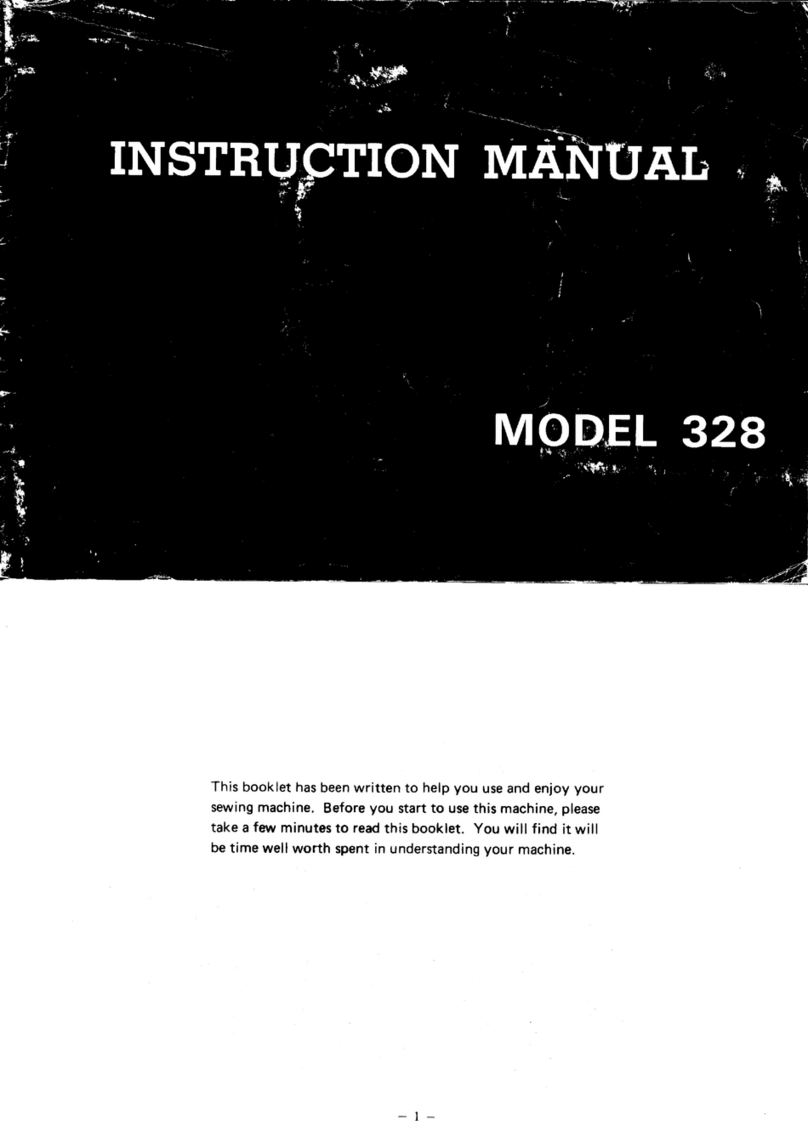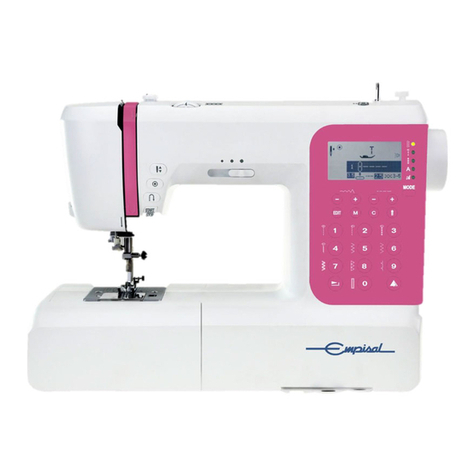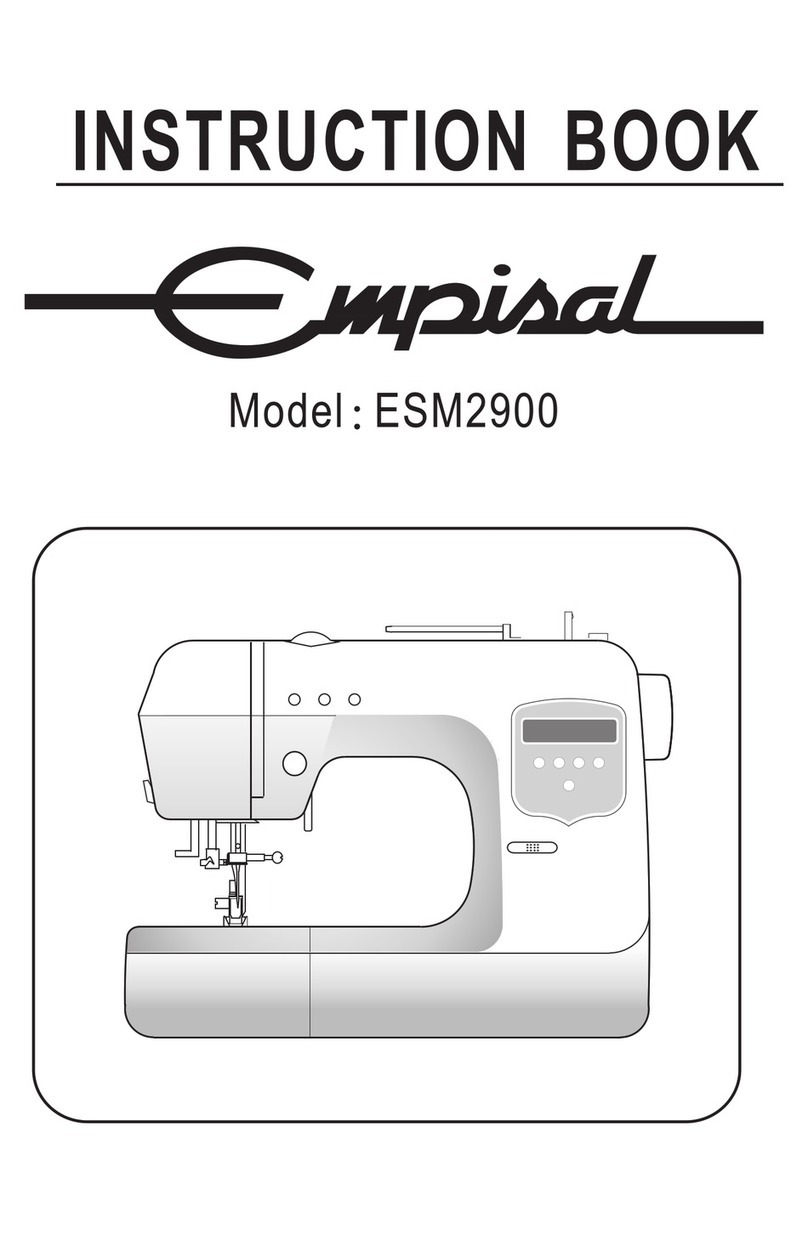Empisal 760 User manual

- 0 -
MODEL: 760
INSTRUCTION MANUAL
EMPISAL COMPLETEFREE ARM OVER LOCKER
your creative assistant

- 1 -
Safety instructions
Like any other electrical device, a sewing machine can cause serious, even
life-threatening injuries. To avoid this, and in order to work safely:
• Before initial use of your sewing machine, read these operating instructions
thoroughly.
• Keep the operating instructions in a suitable place near the machine. When
passing the appliance on to others, always enclose the operating
instructions.
• Always disconnect the power supply when leaving the machine unattended.
This will prevent the risk of accidents if the machine is switched on
accidentally.
• First pull the power plug before changing the bulb or performing maintenance
work on the machine.
This will prevent possibly life-threatening electric shocks.
• Do not remove the plug from the socket by pulling on the cable. Always grip
the plug and not the cable when pulling out the power plug.
• Only use the sewing machine in dry rooms.
Don’t use the machine in wet condition and location.
• In case of any visible damage on the machine, the foot switch or the power
cable: Have the damage repaired by Customer Service before using the
sewing machine again.
• The supply cord cannot be replaced. If the supply cord connected with foot
controller is damaged the foot controller shall be scrapped.
• Never let children or elderly persons handle the machine unsupervised
because they may not properly appreciate the possible dangers. Keep
electrical appliances outside the reach of children.
• Never use the machine when the ventilation apertures are blocked. Keep the
ventilation apertures of the machine and the foot switch free from fluff, dust
and waste material.
• Don’t let children play with sewing machine.
• Never use the machines if the air went are blocked keep the air wends free
form dust, fusel and leftovers.
• Never place anything on the foot controller.
• This appliance can be used by children aged from 8 years and above and
persons with
reduced physical, sensory or mental capabilities or lack of experience and
knowledge if they
have been given supervision or instruction concerning use of the appliance in
a safe way and
understand the hazards involved.
• Children shall not play with the appliance.
• Cleaning and user maintenance shall not be made by children without
supervision.

- 2 -
• Keep your work space tidy. An untidy workplace can lead to accidents.
• Provide adequate lighting when working!
• Do not wear loose clothing or jewelry, as these can be caught in the moving
parts. You should also wear a hair net if you have long hair.
• Avoid abnormal posture. Remain steady and in a well-balanced positionat all
times.
• Be alert! Pay attention to what you are doing. Always take a rational
approach to your work. Never work with the sewing machine if you are
unable to concentrate or if you are feeling unwell!
• If accidents occur as a result of handling the machine with insufficient care, or
failure to follow the safety instructions in this manual, then the manufacturer
cannot accept liability.
• Please use for your sewing machine the ZHEJIANG FOUNDER presser foot,
type KD-2902.
Power rating: 220 - 240V ~ , 50/60Hz
Current rating: 1.0A
Protection Class : II
• The sound pressure level under normal operating conditions is 78dB (A).
• If the supply cord that fixed with foot controller is damaged, it must be
replaced by the manufacturer or its service agent or a similar qualified person
in order to avoid a hazard.

- 3 -
INTRODUCTION
THANK YOU FOR CHOOSING OUR OVERLOCK MACHINE
This overlock machine can stitch dependable seams on all kinds offabric, both light and heavy,
includingcotton, wool, rayon, tricot, jersey, andknits.
You do not need a special table forthis portable machine.
We suggest that you read this instruction manual carefully before you start to operate the machine.
FOR YOUR SAFETY
1. Keep youreyes on the needles when operating the overlock machine. Do not touch the hand
wheel, the cutter or the needles when the machine is running.
2. Turn off the power switch, and pull out the plug from electric socket in the following cases:
*When you have finished your sewing.
*When you leave the over locker temporarily.
*When replacing the parts.
*When cleaning and adjusting the machine.
BEFORE YOU USE
1. Wipe dust and oil off the machine to avoid any stains on the sewing materials.
2. Test sew by using the same sewing materials you intend to sew.
3. Read this instruction manual thoroughly before replacing the cutters and the needles. Follow the
instructions for correct replacements and adjustments.

- 4 -
TABLE OF CONTENTS
NAME OF MAINCOMPONENTS ......................................................................................5-6
SETTING UP YOURMACHINE .........................................................................................7-9
The position of thread stand ...................................................................................7
Cotton holders .......................................................................................................7
Spool caps............................................................................................................7
Connecting the foot control......................................................................................8
Controlling sewing speed ........................................................................................8
Safety switch.........................................................................................................8
ACCESSORIES.................................................................................................................9
USING THE MACHINE...................................................................................................... 10
Hand wheel......................................................................................................... 10
Front cover.......................................................................................................... 10
Free arm............................................................................................................. 10
LOOPER THREADING.......................................................................................................11
NEEDLE THREADING .......................................................................................................12
TRIAL SEWING.................................................................................................................13
ADJUSTING THREAD TENSIONS..................................................................................14-15
Adjusting the needle thread tensions .......................................................................15
Adjusting the looper thread tensions........................................................................15
MACHINEADJUSTMENT CHART.......................................................................................16
CHANGING THE THREAD..................................................................................................17
BUILT-IN POCKETHANDLE...............................................................................................17
ADJUSTMENTOF STITICHSTITCH LENGTH.......................................................................18
Stitch length setting...............................................................................................18
CUTTING WIDTH ..............................................................................................................19
The proper cutting width.........................................................................................19
Adjust to a wider cutting width.................................................................................19
Adjust to a narrower cutting width............................................................................19
CHANGING THE NEEDLE..................................................................................................20
REPLACING THE BULB.....................................................................................................20
REPLACING THE CUTTERS...............................................................................................21
THREE THREAD NARROWANDWIDE OVERLOCK STITCH ................................................22
FREEARM SEWING.........................................................................................................23
CONVERTIBLE PRESSER FOOT.......................................................................................23
ROLLED ANDNARROW EDGE.....................................................................................24-25
Rolled edge..........................................................................................................24
Narrow edge.........................................................................................................24
Rolled hemming....................................................................................................25
Narrow hemming...................................................................................................25
DIFFERENTIAL FEED...................................................................................................26-27
Differential feed mechanism...................................................................................26
Adjusting the differential feed..................................................................................26
Wavy knits & Gathering .........................................................................................27
Stretching to prevent puckering...............................................................................27
TROUBLE SHOOTING GUIDE............................................................................................28
CLEANING ANDLUBRICATING ..........................................................................................29
SPECIFICATION OF MACHINE...........................................................................................29

- 5 -
NAME OF MAIN COMPONENTS
1. Thread stand
2. Lower looper thread tensiondial
3. Spool pin
4. Spool holder
5. Handwheel
6. Base
7. Machine socket
8. Power switch
9. Front cover
10. Support bed
11. Free arm
12. Needle plate
13. Left needle thread tension dial
14. Right needle thread tension dial
15. Upper looper thread tensiondial
16. Thread guide plate
1
2
3
4
5
6
7
8
9
10
11
12
13
16
14
15
Always disconnect the power supply when leaving the machine unattended. This will prevent the
risk ofaccidents ifthe machine is switched on accidentally.

- 6 -
1. Upper looper
2. Lower looper
3. Free arm
4. Lower knife
5. Cutting width adjustment knob
6. Presserfoot
7. Upper knife
2
3
4
5
6
7
1

- 7 -
SETTING UP YOUR MACHINE
Set your Overlock machine on asturdyflat
surface.
[ THE POSITION OF THREAD STAND ]
Pull up thread stand to its highest point before
threading.
Turn the thread stand so the thread guides
come right above the spool pins.
[ COTTON HOLDERS ]
Both industrial cones and domestic type thread
spools can be used on this machine.
For large diameterindustrial cones use the
cone holders with the large end at the top.
For small diametercones. useUse the same
cone holders with the small end at the top.
[ SPOOL CAPS ]
When using domestic type thread spools,
remove the spool holders and place spool
caps over the thread spools.
Normal
Positioning catches
Spool holder
Domestic type
thread spool
Spool cap
Notch

- 8 -
[ CONNECTING THE FOOT CONTROL ]
Push foot control plug into the machine socket and then into main socket.
Turn on the power switch. This power switch controls both the machine power and sewing light.
[ CONTROLLING SEWING SPEED ]
The foot control regulates the sewing speed.
The sewing speed can be adjusted by
increasing or decreasing the pressure on the
foot control.
[ SAFETY SWITCH ]
This machine is equipped with a micro safety
switch.
The machineis automaticallycut offfrom the
motor electricity supplyif front cover is open.
Close both free arm and front cover before
you start sewing.
Foot control
Safety switch
Foot control
Powerswitch
Machine plug
Powersupply plug
Powersupply
Machine socket

- 9 -
ACCESSORIES
Tweezers
Spare uppercutter
Needles
Machine cover
Screwdriver
Brush
Hexagon wrench key
Instruction manual
Spool caps

- 10 -
Open the free arm for threading.
1. Remove the support bed as arrow.
2a. Press and pull up the free arm release lever.
2b. Pull up free arm as arrow way, when hinge
be released from needle plate.
USING THE MACHINE
[ HAND WHEEL]
Always turnhandwheel towardyou, i.e. the
same direction as on a household sewing
machine.
[ FRONT COVER ]
To open front cover, slide the hollowto the
right as far as it will go then pull front cover
toward you.
The front cover won't close while the free arm
is open.
[ FREE ARM ]
○,2
○,1
Free arm
release lever
2a
Hinge
Support bed
Free arm
Needle plate
2b
1

- 11 -
LOOPER THREADING
Warning: Before contriving please adjust main control switch to (OFF).
Correct threading is important otherwise uneven stitches or thread breakage may result.
Aconvenient threading chart is placed on the front panel inside the front cover.
In addition, each thread guide is coloured for
threading indication.
To help in threading, tweezers can be found in
the accessory box.
Threading must be carried out in the following
sequence.
1. FIRST……...Upper looper
2. SECOND…..Lower looper
3. THIRD……...Right needle
4. FINALLY……Left needle
1. Open thefront cover and free arm.
2. Turn the handwheel toward you until. the
looper comes to best position for threading.
3. Pass the upper looper thread and lower
looper thread as illustrated.
Important: The thread must lie correctly
between the two discs inside the tension
dials.
4. Pull out the thread end about 10 cm (4")
long from the looper eyes. Raise the
presser foot and place threads under it,
then lower the presser foot.
Upper looper thread Lowerlooper thread
Error!
Error!
Error!
Error!
Error!
Error!
Error!
Error!
Error!
Error!
Error!
Error!
Error!
Error!
Error!
Error!
Error!
Error!
Error!
8
7
6
5
5
8
5
2
3
4
6
7
Lower looper
Upper looper
Error!
2
Error!
1
3 ○,3
Thread between two discs

- 12 -
NEEDLE THREADING
5. Turn the hand wheel toward you until
needles are fully raised.
6. Pass theright andleft needle threads as
illustrated.
Important: The threadmust lie correctly
between the two discs inside the tension
dials.
Pass through the needle eyes from front to
back as illustrated.
7. Pull out thethreadend about 10 cm (4")
long from the needle eyes. Raise the
presser foot and place threads under it,
then lower the presser foot.
Left needle thread Right needle thread
Error!
Error!
2
Error!
1
3
Error!
Error!
Error!
Error!
Error!
Error!
Error!
Error!
8
5
2
3
4
6
7
6
Error!
Error!
Error!
Error!
8
7
Error!
5
4
6
Error!
Error!
Error!
Thread between two discs

- 13 -
TRIAL SEWING
When the overlock has been threaded for the
first time orre-threaded because of thread
breakage during sewing, start sewing in the
following manner.
Holding the end of threads between your left
finger tips, turn the handwheel slowly toward
you two or three times and check the thread
chain.
Place fabric for trial sewing under the presser
foot and start sewing slowly.
The fabric will be automatically fed.
Guide the fabric as you sew.
When work is finished, continue sewing to
form about 5 cm (2") long thread chain from
the end of fabric.
Cut the threads with a scissor.
Cloth

- 14 -
ADJUSTING THREAD TENSIONS
Thread tensions will vary according to the type and thickness of both thread and fabric.
Adjust the thread tension ofthe machine accordingly while checking the seam.
Thread tension: Turn dial toward smaller numbers, tension becomes loose.
Turn dial toward larger numbers, tensionbecomes tight.
B: Right needle thread
tension dial
D: Lower looper thread
tension dial
C: Upper looper thread
tension dial
A: Left needle thread
tension dial
Correct thread tension
Right needle thread
Left needle thread
Lower looper thread
Back side
Upper looper thread
6 mm (0.24”)

- 15 -
It is necessary to adjust the thread tension for the seams shown below.
[ ADJUSTING THE NEEDLE THREAD TENSIONS ]
[ ADJUSTING THE LOOPER THREAD TENSIONS ]
The left needle thread tension is too loose.
The right needle thread tension is too loose.
The lower looper thread is tight and/or
the upper looper thread is loose.
The upper looper threadis tight and/or
the lower looper thread is loose.
Loosen the lower looper thread tension
and/or tighten the upper looper thread
tension.
Loosen the upper looper thread tension
and/or tighten the lower looper thread
tension.
Tighten the left needle thread tension.
Tighten the right needle thread tension.
Back side
Front side
Back side
Front side
Front side
Front side
Back side
Back side

- 16 -
MACHINE ADJUSTMENT CHART
The best tensionfor onefabric may not be correct foranother.
The required tensions depend upon stiffness and thickness offabric, thread size and type.
If necessary, readjust referring to the chart below.
Fabrics
Threads
Needle
Stitch length
Standard Setting
Light-weight
.Cotton
.Spun
polyester
.Polyester
continuous
No. 80 - 100
HA× 1
No. 11
130 / 705H
No. 80
2.0 - 3.5 mm
.Standard
2.5 mm
.Georgette
.Organdy
.Lawn
.Voile
.Crepe-de-chine
.Silk
etc.
Medium-weight
.Cotton
.Spun
polyester
.Polyester
continuous
No. 60 - 100
HA× 1
No.11-14
130 / 705H
No. 80 - 90
2.0 - 3.5 mm
.Standard
2.5 mm
.Cotton
.Poplin
.Gingham
.Corduroy
etc.
Heavy-weight
.Cotton
.Spun
polyester
.Polyester
continuous
No. 50 - 80
HA× 1
No. 14
130 / 705H
No. 90
2.5 - 4.0 mm
.Standard
3.0 mm
.Denim
.Tweed
.Velour
etc.

- 17 -
CHANGING THE THREAD (TYING ON)
It is simple to change the thread in the following
manner.
Cut the thread above the spool pin, and knot
ends of old and new threads together.
Set the tension dials to "O" and raise the
presserfoot.
Pull the other end of thread until knots come
under the presser foot. For needle threads, pull
theother ends of threads until knots come to
needle eyes and cut the threads at the both
sides ofthe knots. Then re-thread the needles.
BUILT-IN POCKET HANDLE
The Built in pocket handle is a convenient way
tocarry yourmachine.
Pocket handle

- 18 -
ADJUSTMENT OF STITCH LENGTH
There are nine setting adjustments which can be made from 1.0 to 5.0mm.
Most overlock work is done with a basic stitch length setting of2.5-3.5 mm.
[ STITCH LENGTH SETTING ]
Stitches
Stitch length
Regular seaming
Narrow seaming
Rolled edging
Picot edging
2.0 –4.5 mm
3.0 mm (Standard Setting)
1.0 - 2.0 mm
1.0 - 2.0 mm
3.0- 4.0 mm
Stitch length
adjustment knob (lnner dial)

- 19 -
CUTTING WIDTH
The proper cutting width differs with the type offabric. Check the seams each time, and adjust the
cutting width as follows.
1. Turn the hand wheel toward you until the needles are at the lowest position.
2. Open thefront cover and free arm.
3. Turn the cutting width adjustment knob until the looper threads lies along the edge ofthe fabric.
Adjust to a narrower cutting width if the fabric edges curl when sewing. Turn the cutting width
adjustment knob to the right.
Adjust to a wider cutting width ifthe thread loops off the edge of the fabric. Turn the cutting width
adjustment knob to the left.
[ THE PROPER CUTTING WIDTH ]
[ ADJUST TO A WIDER CUTTING
WIDTH ]
Needle plate
Cutting width
adjustment knob
Wide
Narrow
Stitch width
Cutting width
Front side
[ ADJUST TO A NARROWER
CUTTING WIDTH ]
Front side
Front side
Threads looping
off edge of fabric
Stitch curling
edge of fabric
Table of contents
Other Empisal Sewing Machine manuals

Empisal
Empisal Dress Maker 270D User manual
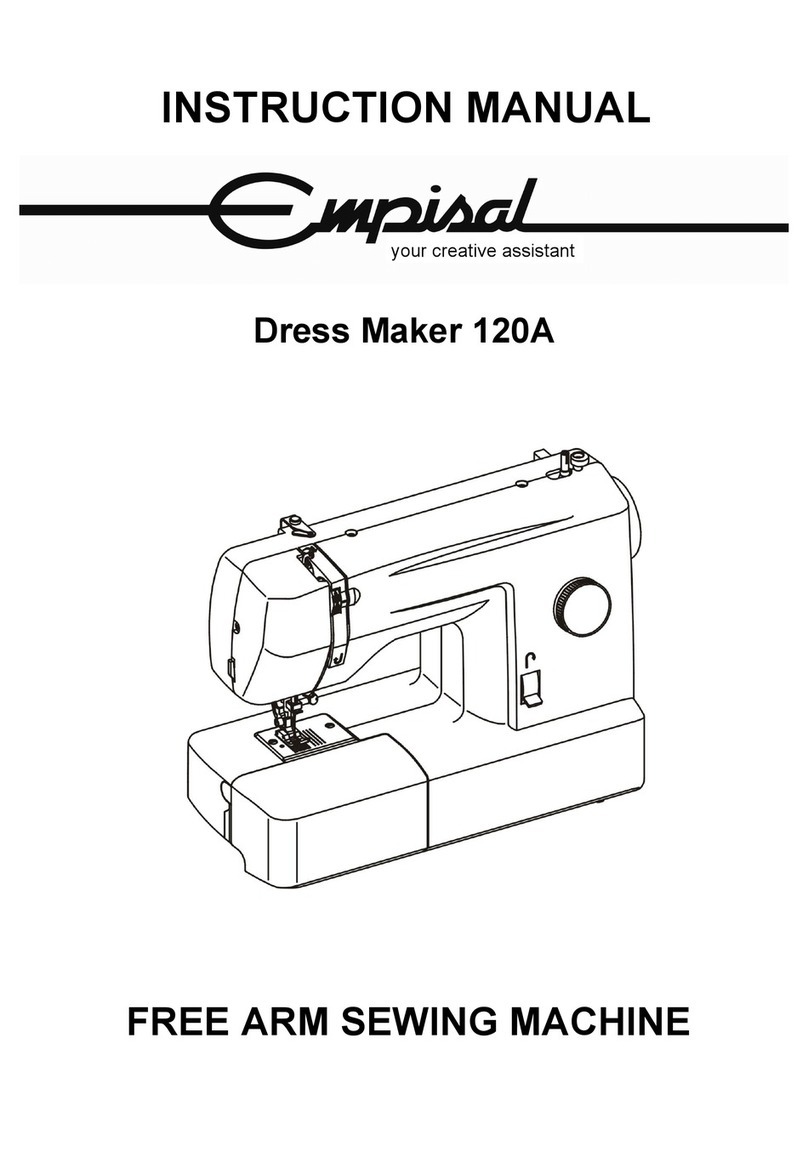
Empisal
Empisal Dress Maker 120A User manual
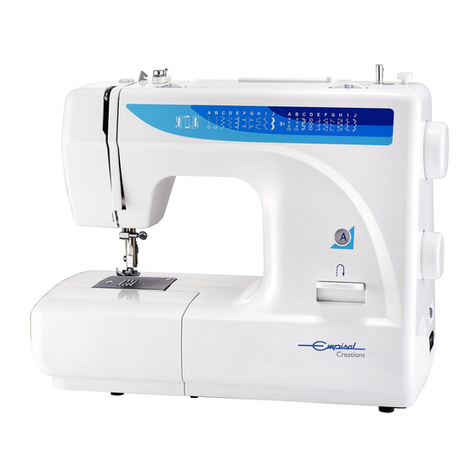
Empisal
Empisal creations User manual
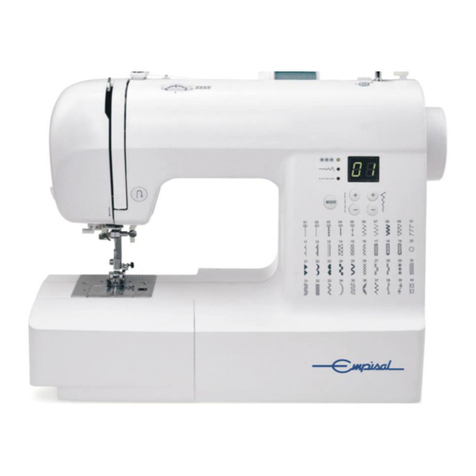
Empisal
Empisal EES10 User manual
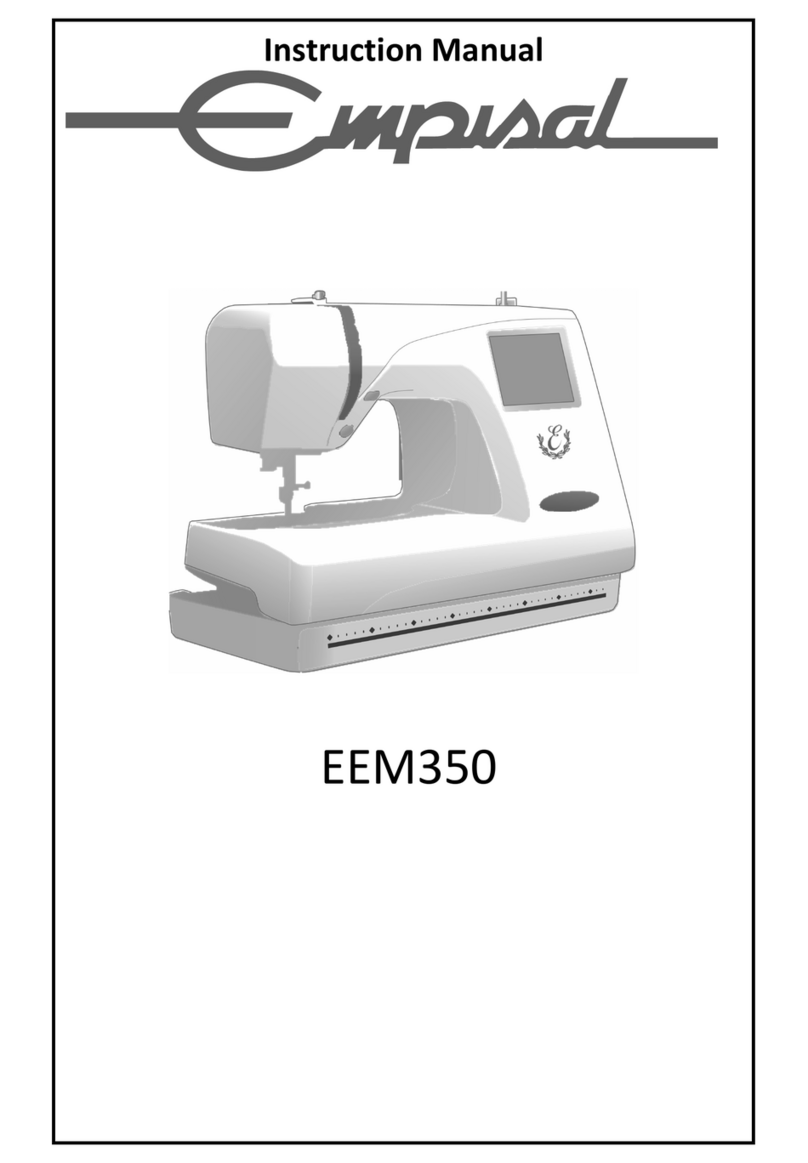
Empisal
Empisal EEM350 User manual
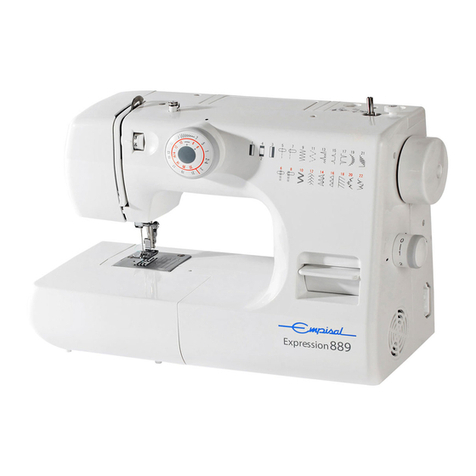
Empisal
Empisal Expression 889 User manual
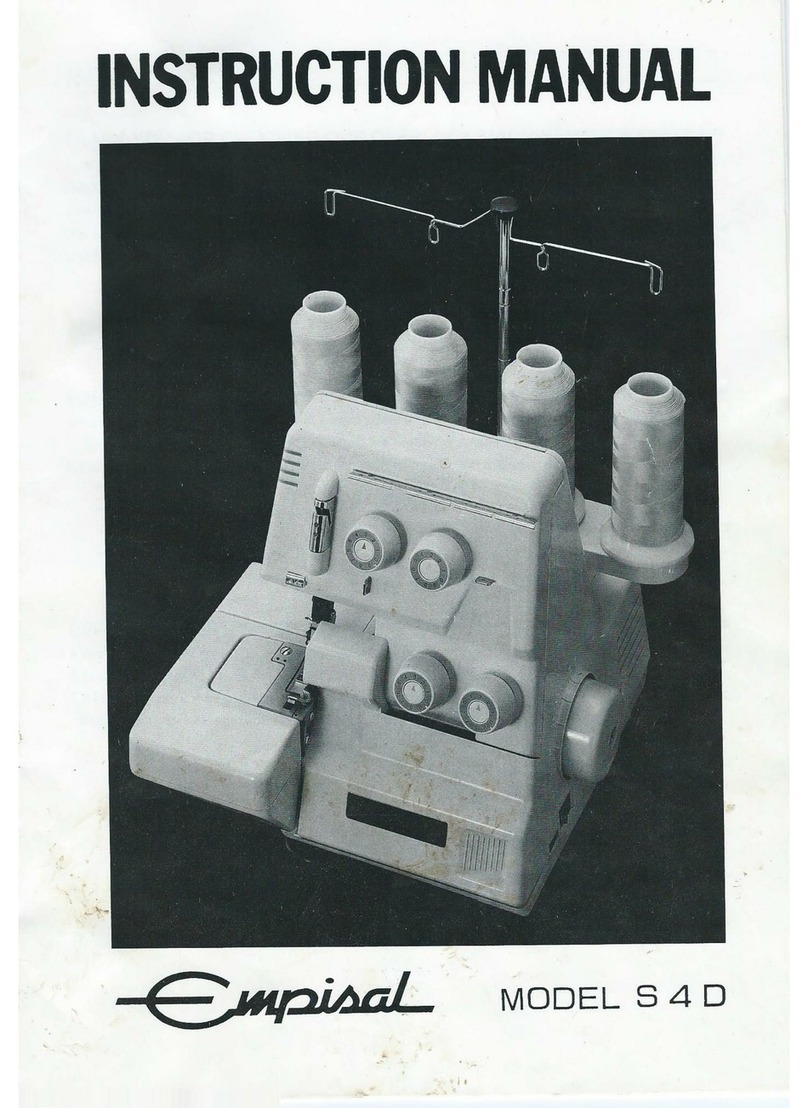
Empisal
Empisal S4D User manual
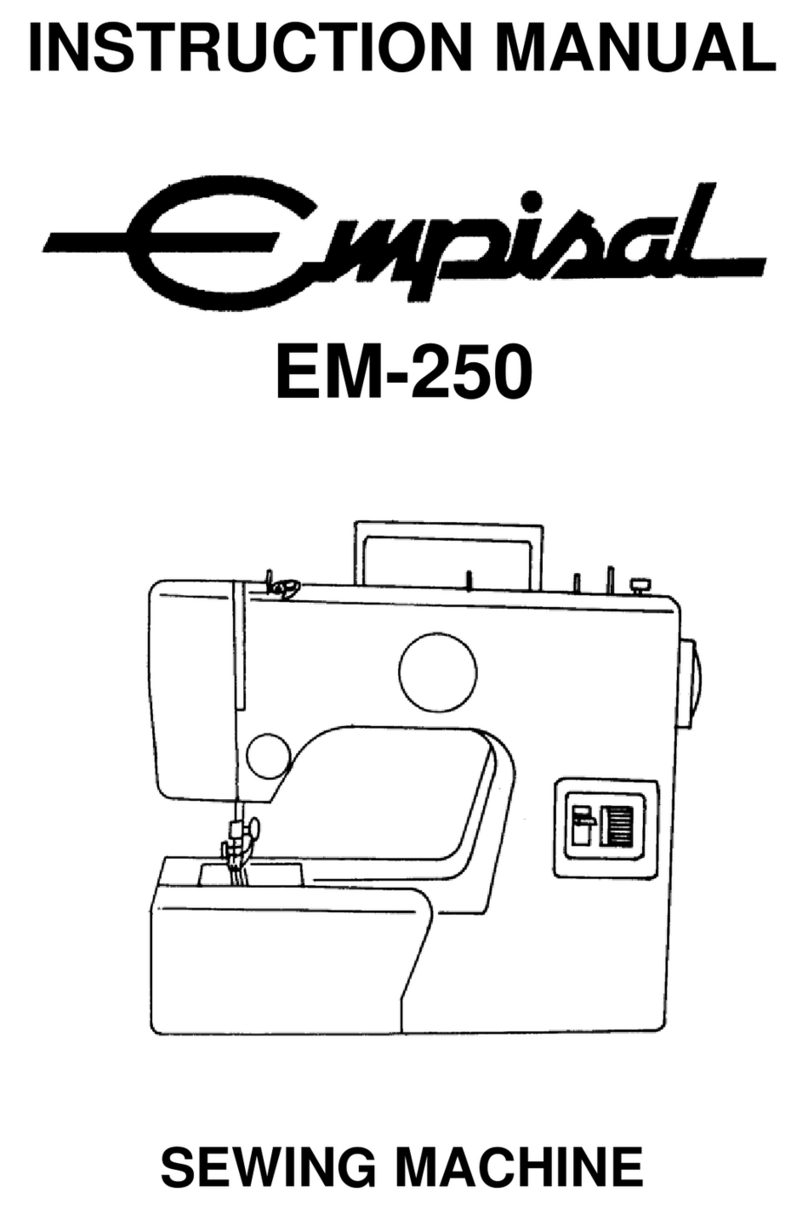
Empisal
Empisal em-250 User manual
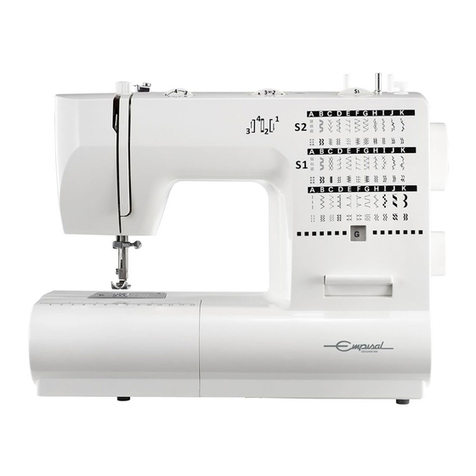
Empisal
Empisal Designer 800 User manual
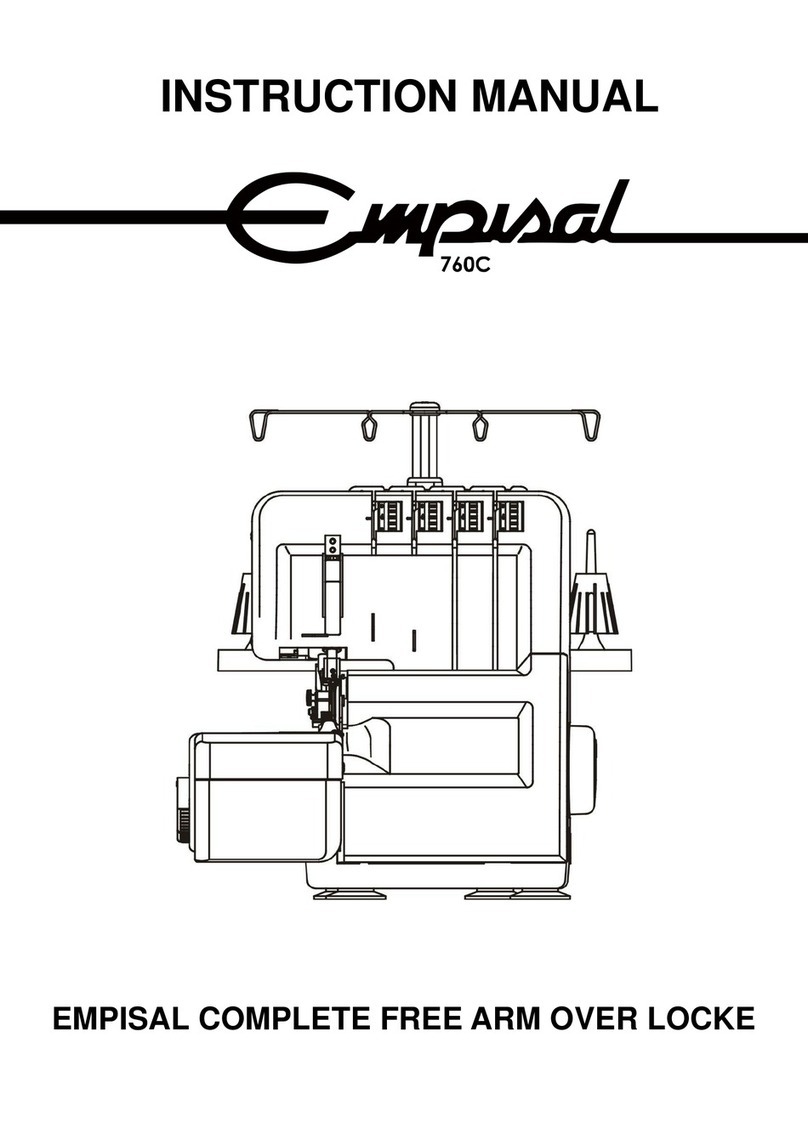
Empisal
Empisal 760C User manual
